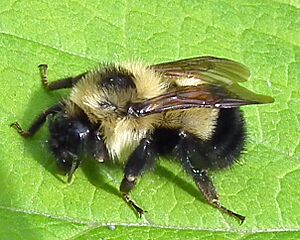Bombus vagans facts for kids
Quick facts for kids Bombus vagans |
|
|---|---|
 |
|
| Conservation status | |
| Scientific classification | |
| Genus: |
Bombus
|
| Species: |
vagans
|
The half-black bumblebee (Bombus vagans) is a small, fuzzy bee that lives across a big part of North America. You can find it from places like Ontario in Canada all the way down to Georgia in the United States.
What Does This Bee Look Like?
The half-black bumblebee is a common type of bumblebee. It has a tongue that's about medium length. Its head and the main part of its body (called the thorax) are yellow. The first two parts of its belly (abdomen) are also yellow. The rest of its belly is black.
The bee's face has a mix of yellow and black hairs. Its thorax is covered in thick, shaggy yellow hair. But right in the middle of its thorax, there's a smooth, shiny spot with no hair. The first two parts of its belly have yellow hairs, and the rest of the belly has black hairs. The underside of this bee and its legs are black. This bee looks a bit like other bumblebees, so it can sometimes be tricky to tell them apart.
How Does This Bee Live?
This bumblebee wakes up from its long winter sleep (called hibernation) a bit later in the year than some other bees. In places like Maine, the first queens are often seen in early May. The worker bees then fly around from June to August. In warmer southern areas, you might see them about a month earlier.
The queen bees really like apple and plum blossoms. The worker bees enjoy flowers like red clover, Penstemon, Asclepias (which is also called milkweed), Cirsium (thistle), Eupatorium, and Spiraea (meadowsweet). Unlike most other bumblebees in its area, this bee likes to find food in shady forest places. The male bees, called drones, are often seen later in the season on aster and goldenrod flowers.
These bees usually build their nests on the ground or in holes in the ground. When a colony is at its biggest, it can have about seventy worker bees. Sometimes, a different type of bee called a cuckoo bumblebee (Bombus citrinus) might try to take over the nest. Also, a tiny germ called Apicystis bombi can sometimes affect these bees.


